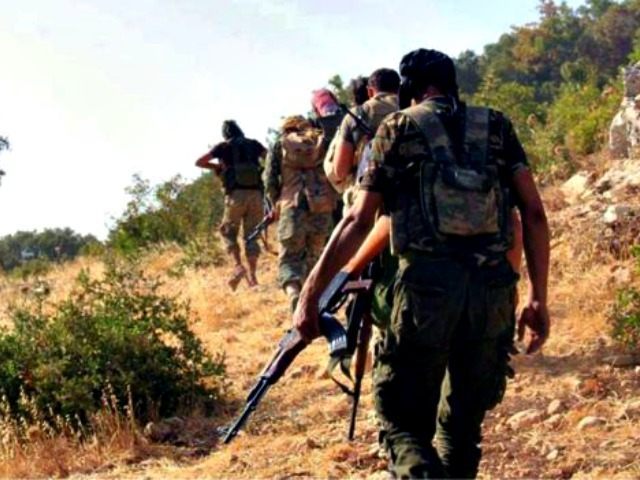The Free Syrian Army (FSA), which includes fighters trained by the U.S. Central Intelligence Agency (CIA), has reportedly been decimated by widespread desertions.
Al Jazeera reports that the Free Syrian Army, a network of mostly former Syrian military soldiers primarily focused on fighting the authoritarian regime of Syrian dictator Bashar al-Assad, “has seen its power wane dramatically this year amid widespread desertions.”
“Nowhere is this more apparent than in Aleppo, Syria’s largest city where many FSA soldiers are leaving the group, citing inadequate pay, family obligations and poor conditions,” adds the report.
Analysts believe that the superior funding, weapons, and overall strength of jihadist groups in Syria have persuaded moderate Syrian rebels and potential FSA recruits to join such factions.
Al Jazeera acknowledges that no data exists on the number or rate of FSA desertions.
However, Mohammad Matoh, 27, a former FSA fighter, believes that “50 have left FSA units in the Aleppo area in 2015 alone.” Matoh ended up deserting the FSA to work at a fast-food restaurant in Aleppo that provided him with better pay.
Al Jazeera learned that salaries for FSA soldiers can be as low as $50 per month, and sometimes the fighters are not paid at all due to lack of funds.
“After the intensification of bombing in [Aleppo], fighters in bombed areas had to get their families out after injuries to them and shelling of their homes,” explained Ahmad Jalal, 21, a field commander in the FSA. “The fighter needs to feed his family and the amount [of his salary] is sometimes not enough to do so or live on.”
The widespread desertions have taken a toll on the strength of the FSA, which was once considered a viable alternative to the rule of Assad.
Columb Strack, a senior Middle East and North Africa analyst at global information company IHS, reportedly said that determining the total number of FSA fighters is difficult.
“The FSA is made up of more than 2,050 factions,” Strack said.
He estimated that there are about 35,000 fighters in the FSA units in southern Syria, adding that estimates for northern FSA factions are harder to determine because the FSA “is so fragmented there.”
Wayne White, a scholar at the Washington D.C.-based Middle East Institute and a former senior U.S. State Department intelligence official, agreed with Strack.
White told Al Jazeera that, “while the FSA’s exact numbers are hard to determine, they are weaker than their Islamist counterparts.”
Strack pointed out that “FSA units vary greatly in their equipment and battle-readiness.”
FSA desertions have become common in Aleppo and northern Syria where jihadists groups such as the al-Qaeda Syrian affiliate, the Nusra Front, have a powerful presence.
Russia has been accused of primarily targeting anti-Assad rebels, including those trained by the CIA, since it began launching airstrikes in Syria in late September, something that may also be triggering FSA desertions.
Islamist rebels are stronger because they have more funding and better weapons, noted White.
“The U.S. and the West became resistant to supplying secular rebels with large quantities of arms because they feared such arms could fall into extremist hands,” he told Al Jazeera.
The Pentagon pulled the plug on its failed program to train and equip so-called moderate Syrian rebels to fight the Islamic State (ISIS/ISIL), which is waging war against both the Assad regime and several rebel groups throughout Syria.
A separate CIA effort has helped train and arm parts of the FSA, but that program has struggled as well because its fighters want to combat the Assad regime, not just ISIS, the Los Angeles Times reported.
Similarly, some analysts, such as Jennifer Cafarella from the Washington D.C.-based Institute for the Study of War, believe that restrictions placed on Syrians eligible for training doomed the Pentagon program to failure, USA Today reported. Cafarella noted that the trainees had to pledge to fight against ISIS, not the Assad regime.
The Free Syrian Army, which is considered moderate when compared to Islamist rebel groups in Syria, was formed at the start of the Syrian civil war in August 2011.
It “began suffering battlefield setbacks as early as 2013, including some to Islamist rebel groups in northern Syria,” notes Al Jazeera. “This prompted some members of the U.S. House Intelligence Committee and the Obama administration to lose faith in the FSA.”
The Pentagon has launched a new effort to arm and equip a new U.S.-backed alliance of rebel groups, called the Democratic Forces of Syria (DFS), shifting away from training.
U.S.-supplied weapons and equipment are expected to be channeled through vetted commanders to thousands of Syrian fighters.
The democratic forces only include units focused on fighting ISIS, excluding FSA fighters.
Nevertheless, analysts believe that U.S. support for the Free Syrian Army has not yet waned, notes Al Jazeera.

COMMENTS
Please let us know if you're having issues with commenting.